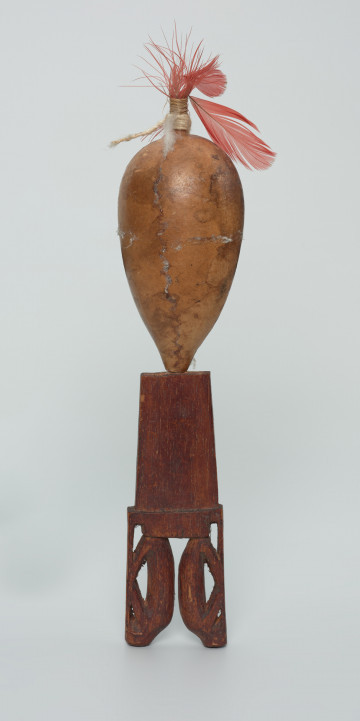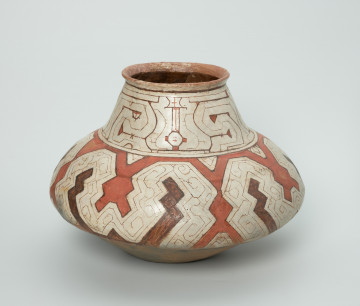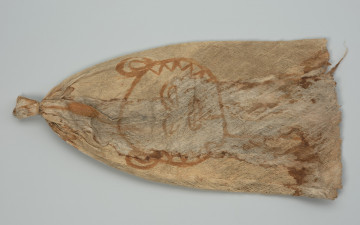
Shaman's maraca, rattle
około 1987
National Museum in Szczecin
Part of the collection: Crafts of the Amazon Indians
The presented basket comes from the Xingu river basin in Brazil. It found its way to the collection of the National Museum in Szczecin thanks to the cooperation with Anna Kowalska-Lewicka, an ethnologist and Americanist, who conducted ethnological research in South America in the 1940s. It was most likely used to store personal items such as pipes, combs and snuff boxes. The Indians placed them relatively high, practically under the very roof of the hut, protecting the baskets' contents from pests and children. Among the woven products of the Amazon Indians, one can distinguish objects made on an ad hoc basis, which could be abandoned and quickly replaced with new ones. The tropical forest provides an enormous amount of palms, bamboos, creepers, and reeds, which are used in braiding after special processing. Only a knife is used to harvest them, while the skilful fingers and teeth of the braider are sufficient for weaving. The Indians also make reusable braided objects, in the making of which the braider puts more effort. Many of these are decorated with geometric patterns, which are achieved by using fibres of two different colours; naturally light fibres are dyed in a dark colour. The range of woven objects is vast. In Indian languages, there is no single word to describe woven objects, but many words convey their function. Otis Tufton Mason, an American ethnologist, distinguished as many as 116 functions of Indian braided objects. Braiding is primarily associated with obtaining food. These products are most often used for collecting, transporting, storing, drying, pressing, straining, mixing, cooking and finally serving food. Braided objects are also used for trade and local celebrations, and the designs on them tell stories related to Indian cosmology and mythology.
Katarzyna Findlik-Gawron
Author / creator
Dimensions
cały obiekt: height: 24,3 cm, width: 29,7 cm
Object type
container
Creation time / dating
Creation / finding place
Identification number
Location / status

około 1987
National Museum in Szczecin

około 1951 — 2000
National Museum in Szczecin

około 1960
National Museum in Szczecin
DISCOVER this TOPIC
Castle Museum in Łańcut
DISCOVER this PATH
Educational path